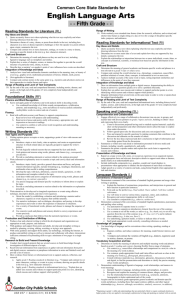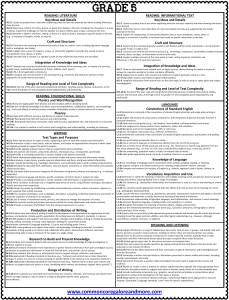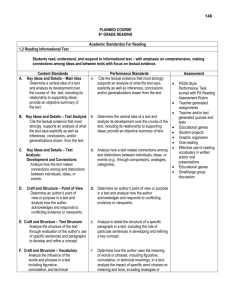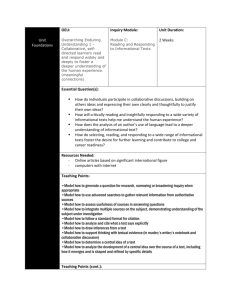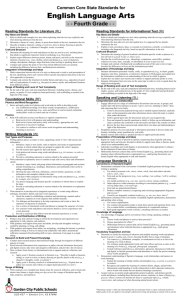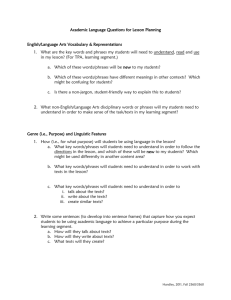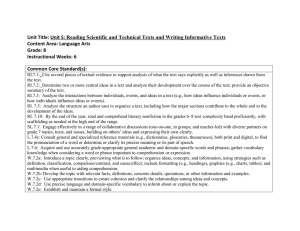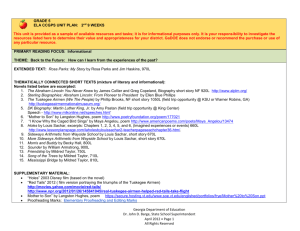Fifth_Grade_RLA_Common_Core_State_Standards
advertisement
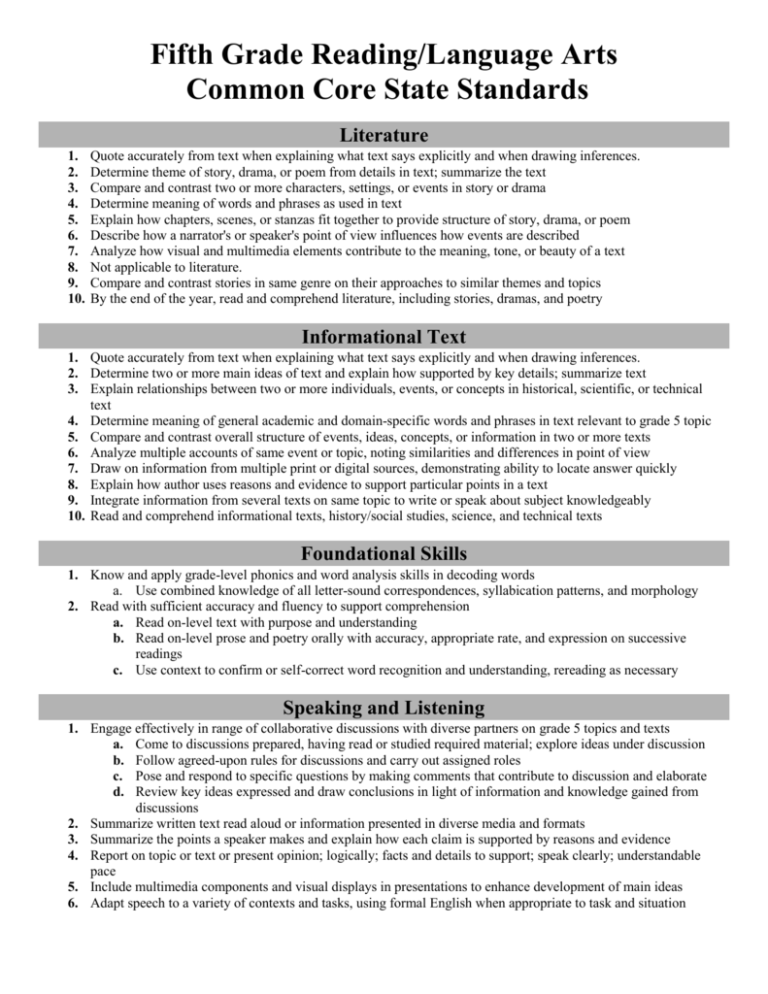
Fifth Grade Reading/Language Arts Common Core State Standards Literature 1. 2. 3. 4. 5. 6. 7. 8. 9. 10. Quote accurately from text when explaining what text says explicitly and when drawing inferences. Determine theme of story, drama, or poem from details in text; summarize the text Compare and contrast two or more characters, settings, or events in story or drama Determine meaning of words and phrases as used in text Explain how chapters, scenes, or stanzas fit together to provide structure of story, drama, or poem Describe how a narrator's or speaker's point of view influences how events are described Analyze how visual and multimedia elements contribute to the meaning, tone, or beauty of a text Not applicable to literature. Compare and contrast stories in same genre on their approaches to similar themes and topics By the end of the year, read and comprehend literature, including stories, dramas, and poetry Informational Text 1. Quote accurately from text when explaining what text says explicitly and when drawing inferences. 2. Determine two or more main ideas of text and explain how supported by key details; summarize text 3. Explain relationships between two or more individuals, events, or concepts in historical, scientific, or technical text 4. Determine meaning of general academic and domain-specific words and phrases in text relevant to grade 5 topic 5. Compare and contrast overall structure of events, ideas, concepts, or information in two or more texts 6. Analyze multiple accounts of same event or topic, noting similarities and differences in point of view 7. Draw on information from multiple print or digital sources, demonstrating ability to locate answer quickly 8. Explain how author uses reasons and evidence to support particular points in a text 9. Integrate information from several texts on same topic to write or speak about subject knowledgeably 10. Read and comprehend informational texts, history/social studies, science, and technical texts Foundational Skills 1. Know and apply grade-level phonics and word analysis skills in decoding words a. Use combined knowledge of all letter-sound correspondences, syllabication patterns, and morphology 2. Read with sufficient accuracy and fluency to support comprehension a. Read on-level text with purpose and understanding b. Read on-level prose and poetry orally with accuracy, appropriate rate, and expression on successive readings c. Use context to confirm or self-correct word recognition and understanding, rereading as necessary Speaking and Listening 1. Engage effectively in range of collaborative discussions with diverse partners on grade 5 topics and texts a. Come to discussions prepared, having read or studied required material; explore ideas under discussion b. Follow agreed-upon rules for discussions and carry out assigned roles c. Pose and respond to specific questions by making comments that contribute to discussion and elaborate d. Review key ideas expressed and draw conclusions in light of information and knowledge gained from discussions 2. Summarize written text read aloud or information presented in diverse media and formats 3. Summarize the points a speaker makes and explain how each claim is supported by reasons and evidence 4. Report on topic or text or present opinion; logically; facts and details to support; speak clearly; understandable pace 5. Include multimedia components and visual displays in presentations to enhance development of main ideas 6. Adapt speech to a variety of contexts and tasks, using formal English when appropriate to task and situation Writing 1. Write opinion pieces on topics or texts, supporting a point of view with reasons and information a. Introduce topic or text clearly, state opinion, and create structure in which ideas are logically grouped b. Provide logically ordered reasons that are supported by facts and details c. Link opinion and reasons using words, phrases, and clauses d. Provide a concluding statement or section related to the opinion presented. 2. Write informative/explanatory texts to examine a topic and convey ideas and information clearly a. Introduce topic clearly, provide observation and focus, and group information logically; formatting and multimedia b. Develop topic with facts, definitions, details, quotations, or other information and examples c. Link ideas within and across categories of information using words, phrases, and clauses d. Use precise language and domain-specific vocabulary to inform about or explain the topic e. Provide a concluding statement or section related to the information or explanation presented 3. Write narratives to develop real or imagined experiences or events using effective technique, details, and sequences a. Orient reader by establishing situation and introducing narrator and/or characters; sequence that unfolds naturally b. Use narrative techniques to develop experiences and events or show responses of characters to situations c. Use a variety of transitional words, phrases, and clauses to manage the sequence of events d. Use concrete words and phrases and sensory details to convey experiences and events precisely e. Provide a conclusion that follows from the narrated experiences or events 4. Produce clear and coherent writing; development and organization are appropriate to task, purpose, and audience 5. Develop and strengthen writing as needed by planning, revising, editing, rewriting, or trying a new approach 6. Use technology, including Internet, to produce and publish writing; collaborate; keyboarding skills-two pages 7. Conduct short research projects that use several sources to build knowledge through investigation 8. Recall or gather information from print and digital sources; summarize or paraphrase; list sources 9. Draw evidence from literary or informational texts to support analysis, reflection, and research a. Apply grade 5 Reading standards to literature b. Apply grade 5 Reading standards to informational texts 10. Write routinely over extended and shorter time frames for range of discipline-specific tasks, purposes, and audiences Language 1. Demonstrate command of the conventions of standard English grammar and usage when writing or speaking a. Explain function of conjunctions, prepositions, and interjections in general and function in particular sentences b. Form and use the perfect verb tenses c. Use verb tense to convey various times, sequences, states, and conditions d. Recognize and correct inappropriate shifts in verb tense e. Use correlative conjunctions 2. Demonstrate command of the conventions of standard English capitalization, punctuation, and spelling when writing a. Use punctuation to separate items in a series b. Use a comma to separate an introductory element from the rest of the sentence c. Use comma to set off words yes and no, tag question and indicate direct address d. Use underlining, quotation marks, or italics to indicate titles of works e. Spell grade-appropriate words correctly, consulting references as needed 3. Use knowledge of language and its conventions when writing, speaking, reading, or listening a. Expand, combine, and reduce sentences for meaning, reader/listener interest, and style b. Compare and contrast the varieties of English used in stories, dramas, or poems 4. Determine or clarify meaning of unknown and multiple-meaning words and phrases based on grade 5 reading and content a. Use context as a clue to the meaning of a word or phrase b. Use common, grade-appropriate Greek and Latin affixes and roots as clues to the meaning of a word c. Consult reference materials, print and digital, to find pronunciation and meaning of key words and phrases 5. Demonstrate understanding of figurative language, word relationships, and nuances in word meanings a. Interpret figurative language, including similes and metaphors, in context b. Recognize and explain the meaning of common idioms, adages, and proverbs c. Use the relationship between particular words to better understand each of the words 6. Acquire and use academic and domain-specific words and phrases

